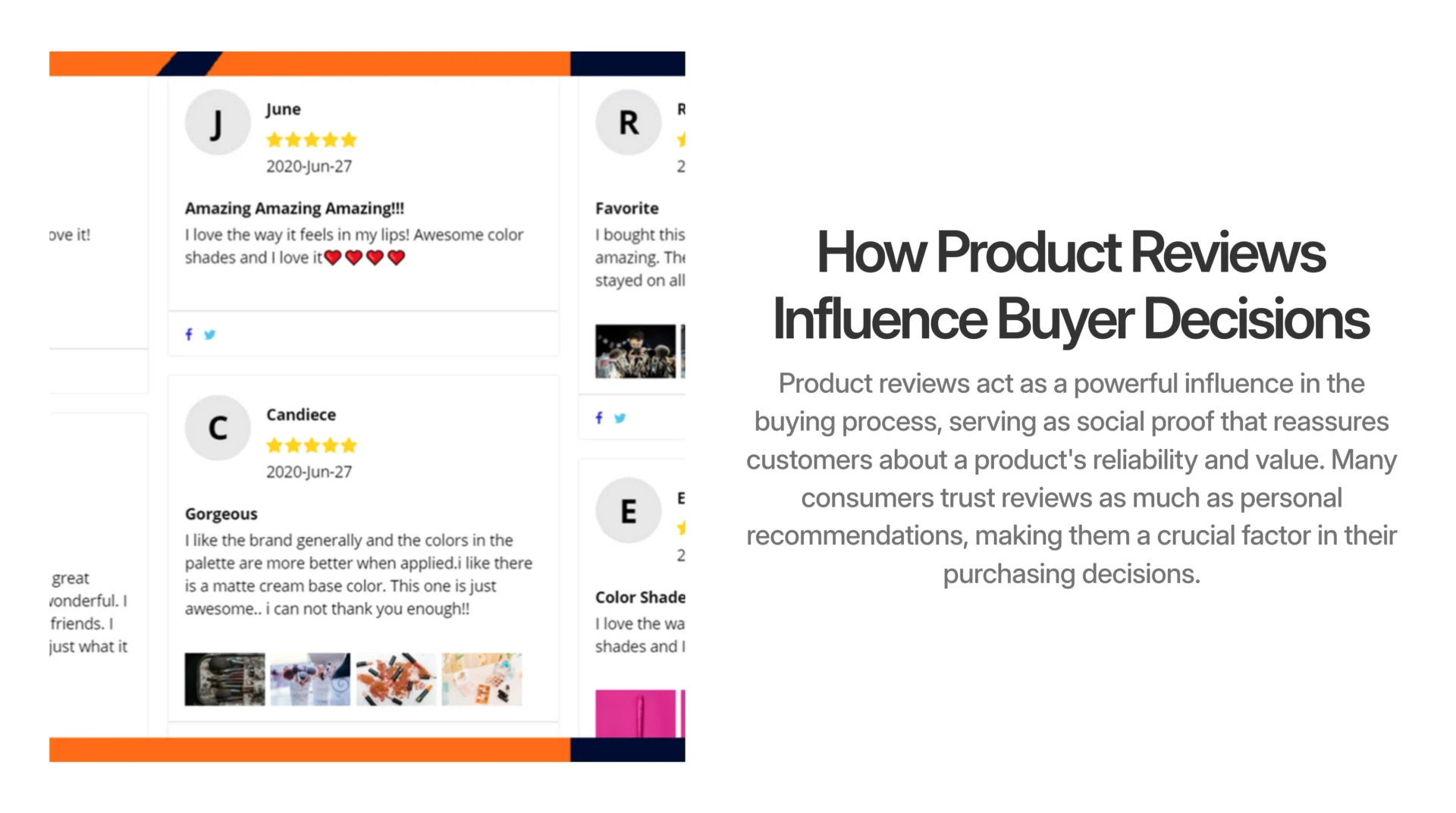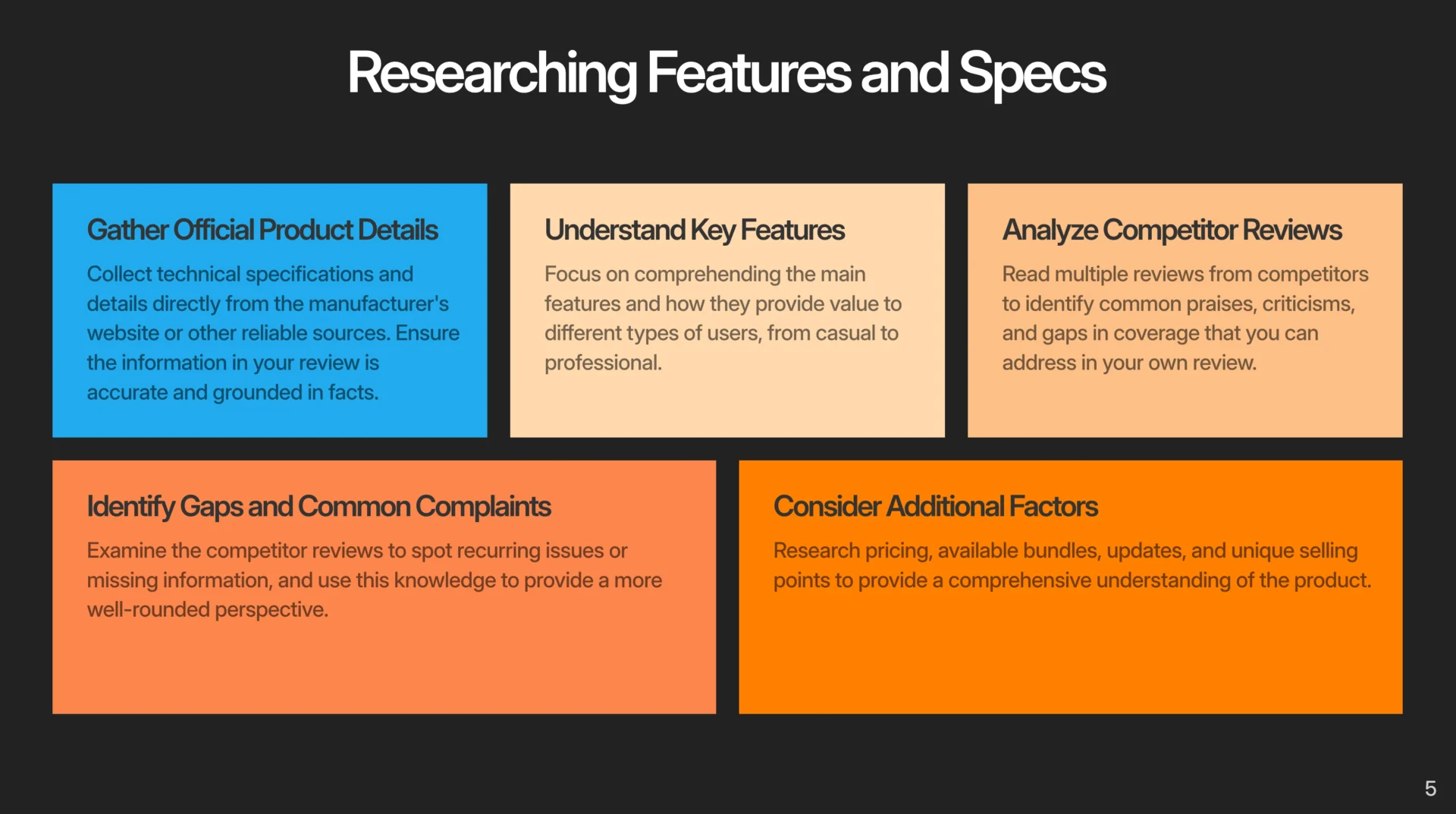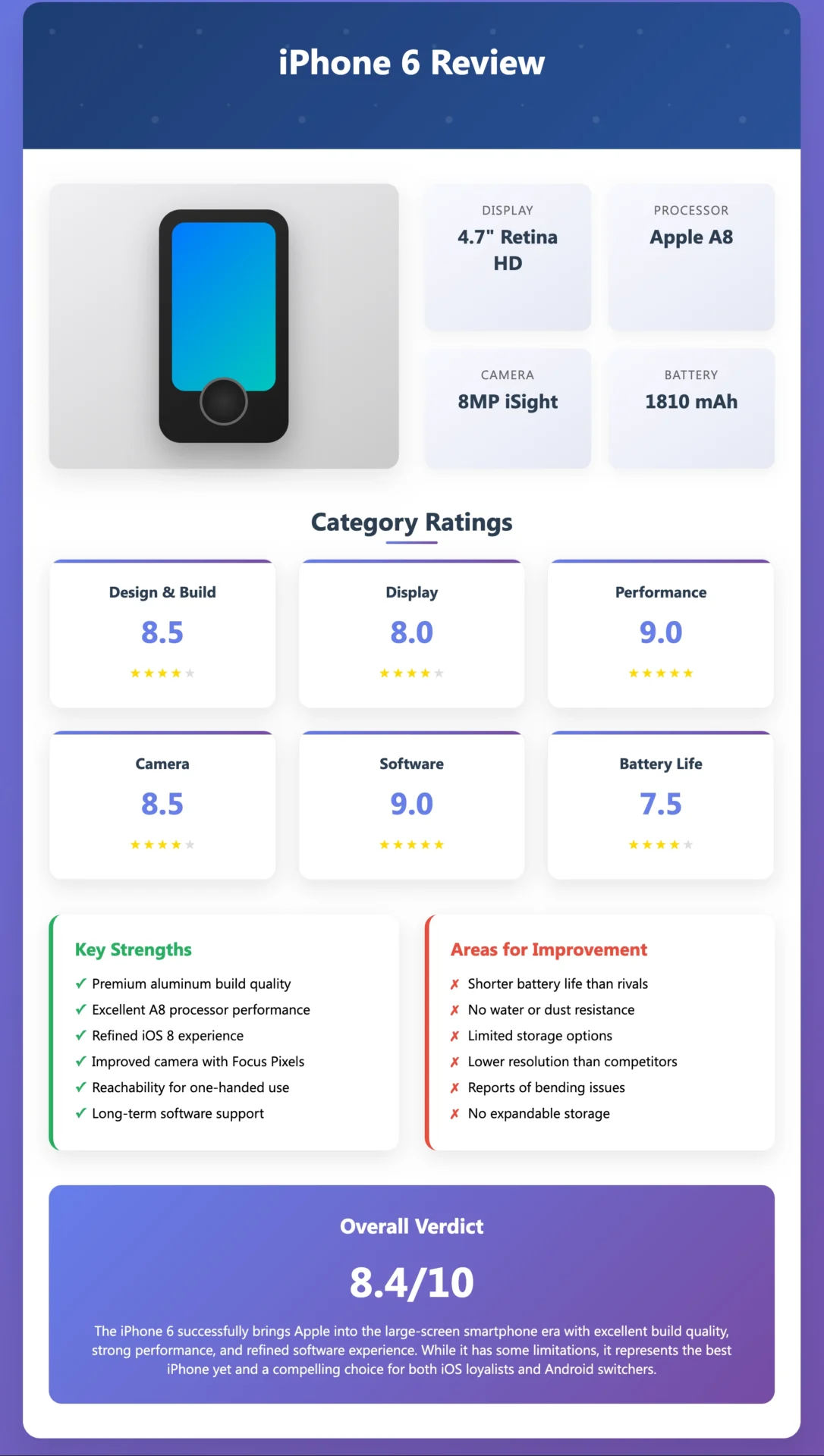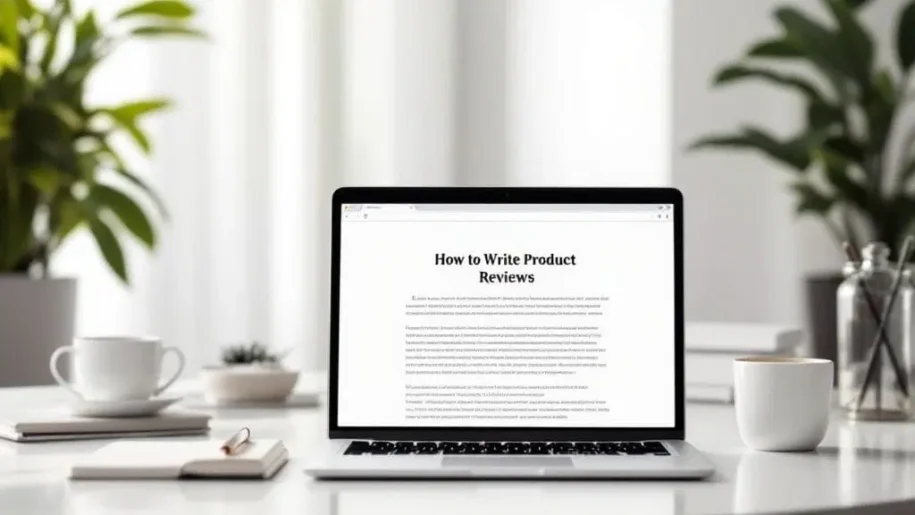Writing a good product review starts with understanding what it really is: sharing your honest experiences and useful details about its features, quality, and performance to help others decide. Before writing, know who you’re talking to and pick a product you’ve used enough to give a genuine opinion.
Research the specs and check out competitors’ reviews to find what’s missing or unique in yours. Structure the review clearly, start with an attention-grabbing headline, follow with pros and cons, include real-life usage examples, and add visuals if possible.

Be honest yet balanced; reveal both strengths and weaknesses while staying open about any partnerships. Finally, summarize your takeaways clearly and invite readers to engage for trustworthiness that truly connects.
What Defines a Product Review and Its Purpose
A product review is more than just an opinion; it is an evaluation based on personal experience that covers quality, features, usability, and overall performance. Its main purpose is to provide honest insights that help potential buyers make informed decisions before investing in a product.
Reviews can come from everyday customers, experts, or professionals and appear across various platforms such as blogs, e-commerce sites, and social media. Good reviews often include comparisons with similar products, helping readers see how one item stacks up against competitors.
Including real-life usage scenarios adds authenticity and makes the review relatable, showing how the product performs in practical situations. Balanced reviews clearly list both pros and cons, offering a fair perspective rather than just praise or criticism.
While the tone can range from objective and critical to enthusiastic, it should always remain genuine and transparent about the reviewer’s level of experience. Covering aspects like design, build quality, ease of use, and detailed explanations of features helps readers understand the benefits and possible drawbacks.
Ultimately, a well-crafted product review builds trust by being clear, honest, and helpful, guiding readers toward smarter purchasing choices.
How Product Reviews Influence Buyer Decisions
Product reviews play a crucial role in shaping buyer decisions by acting as social proof that reassures customers about a product’s reliability and value. Many consumers trust reviews as much as, or even more than, personal recommendations, making them a powerful influence in the buying process.
Detailed reviews help highlight features that matter most to specific needs, allowing buyers to see how a product fits their unique situation. Positive reviews not only boost a product’s visibility but also increase sales conversions by building confidence.

Meanwhile, negative or balanced reviews set realistic expectations, which helps reduce returns and dissatisfaction. Reviews also greatly impact brand reputation since they reflect genuine user experiences, giving potential buyers a transparent view of what to expect.
From an SEO perspective, fresh and unique review content helps pages rank higher in search engines, attracting more traffic. Brands that respond to reviews, including critical ones, demonstrate engagement and care, which further builds trust.
Additionally, reviews encourage buyers to research products more thoroughly and compare options, helping them avoid costly mistakes by uncovering hidden flaws or benefits. For example, a detailed review revealing a smartphone’s battery issues might save a buyer from a disappointing purchase, while another highlighting a product’s durability can tip the decision in its favor.
Choosing the Right Product and Audience for Your Review
Start by clearly identifying your target audience: understand their age, interests, needs, and the problems they face. This helps you pick products that matter to them and fit their daily lives. For example, if your readers are busy parents, choosing time-saving kitchen gadgets or educational toys makes sense.
Always use the product yourself before reviewing it to give honest, detailed insights rather than just repeating specs or marketing claims. Consider products that are popular or in demand, as these will attract more readers searching for information.
At the same time, analyze what competitors have covered and look for gaps or fresh perspectives you can offer. Pick products with clear features and benefits so you can discuss them meaningfully and add value beyond what the manufacturer says.
Focus on niches where your knowledge stands out and you can build a loyal audience. Also, match the product’s complexity with your expertise, reviewing a high-tech device requires solid understanding to maintain credibility.
Lastly, keep SEO in mind by choosing products with common search terms and user queries to increase visibility and traffic to your review.
- Identify your audience’s demographics, preferences, and pain points first
- Choose products relevant to their interests and everyday needs
- Use products personally to provide authentic and detailed insights
- Consider product popularity and demand to increase review relevance
- Analyze competitors’ reviews to find content gaps or unique angles
- Select products with clear features and benefits to discuss
- Focus on products where you can add value beyond manufacturer info
- Target niches where your voice can stand out and attract loyal readers
- Match the product complexity with your expertise level for credible reviews
- Keep SEO in mind: pick products with searchable keywords and queries
Researching Features, Specs, and Competitor Reviews
Start by gathering official product specifications and technical details directly from the manufacturer’s website or trusted sources. This ensures your review is accurate and grounded in facts.
Focus on understanding the key features and how they benefit different types of users, for example, a feature that appeals to casual users might be different from what professionals look for. Next, read multiple competitor reviews to see how others cover the product, noting what points are commonly praised or criticized.
This helps you identify gaps or common complaints to address in your review, adding value for your readers. Also, collect pricing information and check for available bundles or purchase options, as these often influence buying decisions.
Look for unique selling points that set the product apart from competitors, whether it’s a special function, design, or warranty. Don’t forget to check for updates, newer versions, or recalls that might affect the product’s current standing.
Forums and Q&A sites are great places to spot typical user problems or questions, which you can clarify in your review to assist potential buyers. Using keyword research tools to find popular search terms related to the product helps you tailor your content for better visibility and relevance.
Finally, always verify your facts and statistics through reliable sources to maintain credibility and trust with your audience.
Crafting a Clear and Engaging Review Structure
A well-organized review helps readers quickly grasp the value and details of a product. Start with a headline that either highlights the product’s main benefit or poses a question to spark curiosity, such as “Is This Smartwatch Worth Your Money?”
The introduction should briefly explain what the product is, its intended use, and who would benefit most from it. Including a summary box near the top with ratings, pros, cons, and key specifications offers a snapshot for readers who want quick insights.
Break the body of your review into clear sections: begin with an overview and unboxing experience, then dive into features and benefits with real-world examples. Cover pricing and value comparisons next, followed by a straightforward list of pros and cons.
Evaluate performance based on your testing, and include competitor comparisons using tables or charts to give context. Use bullet points and subheadings to make scanning easy and keep paragraphs short to maintain attention.
Visuals such as photos, screenshots, or videos not only support your claims but also make the review more engaging. Finally, wrap up with a concise summary that reinforces your overall verdict, and add a call to action encouraging readers to try the product, leave feedback, or share the review.
Consistent formatting and clear fonts throughout the review improve readability and present your insights professionally.
| Section | Purpose | Details | Example |
|---|---|---|---|
| Headline | Grab attention | Highlight key benefits or ask a compelling question | Is [Product] Worth It? |
| Introduction | Set expectations | Outline product purpose and target users | Perfect for casual photographers |
| Summary Box | Quick overview | Include ratings, pros, cons, essential specs | 4.5 stars, Good battery life, Limited zoom |
| Organized Sections | Improve readability | Overview, features, pricing, pros/cons, performance, comparisons | Feature deep dive and competitor chart |
| Visuals | Support claims | Photos, charts, videos | Comparison table and usage photos |
| Call to Action | Encourage engagement | Invite trying, comments, sharing | Try it now or leave your review |
Writing Honest and Detailed Review Content
When writing product reviews, honesty is key. Share your personal experience with the product, describing how it performed in real scenarios. For example, if reviewing a wireless earbud, talk about battery life during daily commutes or sound quality in noisy environments.
Listing detailed pros and cons based on your hands-on testing helps readers weigh the product’s strengths and weaknesses. Be clear when explaining technical features, avoiding jargon or complicated terms.
Instead of saying “the chipset uses advanced DSP technology,” explain it simply, like “the earbud processes sound to reduce background noise.” Use specific examples to show how the product solves problems or meets needs, such as how a backpack’s waterproof material kept your gear dry during a sudden rainstorm.
It’s important to point out any limitations or unexpected issues you encountered, like a software glitch or short charging cable, to maintain trust. Incorporate a straightforward rating system, stars or points, with brief explanations for each score, so readers understand your evaluation.
Transparency also matters: if your review includes affiliate links or sponsorships, disclose them clearly. Finally, write in a conversational tone that feels approachable and trustworthy.
Avoid exaggerated claims or overly promotional language, and anticipate questions buyers might have, such as compatibility or warranty concerns, addressing them within your review.
Testing and Assessing Product Performance
To write a trustworthy product review, it’s essential to test the product thoroughly over a reasonable period. Using the product in real-life scenarios helps you evaluate its reliability and durability beyond initial impressions.
Start by examining the setup process, noting how easy or complex it is for a new user to get started. Next, assess the core functions and features to verify if they meet the manufacturer’s claims.
For tech products, pay special attention to the software interface, compatibility with other devices, and overall speed or responsiveness. During testing, carefully observe any defects, malfunctions, or drops in performance, as these can be crucial for potential buyers.
If possible, compare the product’s actual performance metrics with those of competitor products to provide context and a clearer picture of value. Don’t overlook user comfort and ergonomics, especially if the product is handheld or worn.
Consider practical design elements and how they affect daily use. Environmental factors like battery life or weather resistance should also be evaluated when relevant, since these can impact usability.
Be sure to document testing conditions, such as usage duration, environment, and any special circumstances, so readers understand the context of your findings. Finally, summarize the product’s strengths and weaknesses based on your real-world experience, giving readers honest insights they can trust when making a purchase decision.
Summarizing Your Thoughts with a Clear Verdict
When wrapping up your product review, focus on highlighting the key points that readers should remember. Clearly state whether you recommend the product and specify which types of users will benefit most from it.
For example, a laptop might be ideal for students due to its portability but less suited for graphic designers needing high performance. If the product isn’t a perfect fit for everyone, suggest alternatives that better serve other needs.
Keep your summary concise and straightforward, avoiding any new information that wasn’t covered earlier. Reinforce your transparency by reminding readers that your verdict is based on thorough testing and research.
Adding a final rating or score helps readers quickly grasp your overall evaluation. Encourage engagement by inviting readers to share their own experiences or ask questions, and close with a clear call to action, such as checking the product link or leaving a comment.
This approach ensures your conclusion is both helpful and trustworthy, guiding readers toward informed decisions.
Learning from Top Expert Review Examples
Studying reviews from top sites like Amazon, 91 Mobiles, and G2 Crowd offers valuable lessons on how to create balanced and engaging product evaluations. These experts blend technical details with personal opinions, making their reviews both informative and relatable.
For instance, they often use comparison tables and visual aids to highlight key differences between products, helping readers quickly grasp what sets each item apart. Storytelling is another tool they use effectively, sharing real-life experiences that connect with the audience on a personal level.
Transparency is a hallmark of their approach, they openly disclose affiliate links or partnerships, which builds trust. Their handling of pros and cons is straightforward, presenting strengths and weaknesses honestly to maintain credibility.

Additionally, many top reviewers actively engage with their readers by responding to comments and updating reviews as products evolve. The tone and language are carefully tailored to appeal to their target audience, striking a balance between professionalism and approachability.
Another important aspect is how they naturally weave SEO keywords into the content, boosting search visibility without sacrificing readability. By analyzing these examples, you can adopt their clear structure, honesty, and engagement strategies as templates for writing your own trustworthy, user-friendly product reviews.
Using SEO and Reader Engagement Tips to Improve Reviews
Integrating SEO strategies into your product reviews can significantly boost their visibility and reach. Start by researching relevant keywords your target audience is searching for and naturally incorporate them into headings, subheadings, and throughout the content.
Clear, descriptive headings with keywords not only improve search rankings but also help readers navigate the review easily. Writing compelling meta descriptions that summarize the review and spark curiosity encourages users to click through from search engines.
To avoid penalties and keep your content fresh, add unique insights and personal experiences rather than repeating manufacturer descriptions or copying other reviews. Encouraging reader engagement is essential: ask questions, invite comments, and respond to feedback to build a community around your reviews.

Regularly updating your reviews ensures the information stays current and useful, which both readers and search engines appreciate. Optimize your page speed by compressing images and using proper formatting, as a fast-loading page improves user experience and SEO.
Internal linking to related reviews or relevant blog posts keeps visitors on your site longer, increasing engagement and reducing bounce rates. Finally, monitor your analytics to understand which parts of your review resonate most with readers and adjust your content accordingly.
Remember to balance SEO tactics with natural, readable writing to maintain trust and keep your audience coming back.
An iPhone 6 Complete Example Review:
Review Steps and Methodology
Step 1: Initial Assessment
- Unboxing Experience: Evaluate packaging, included accessories, and first impressions
- Physical Inspection: Examine build quality, materials, and design elements
- Setup Process: Test initial configuration and user experience
Step 2: Design and Build Quality Analysis
- Form Factor: Measure dimensions and assess ergonomics
- Materials: Analyze aluminum unibody construction and glass quality
- Durability: Test for structural integrity and common wear points
Step 3: Display Evaluation
- Screen Technology: Assess IPS LCD Retina HD display
- Resolution Testing: Evaluate 750×1334 pixel density and sharpness
- Color Accuracy: Test brightness, contrast, and color reproduction
- Viewing Angles: Check display performance from different positions
Step 4: Performance Testing
- Processor Assessment: Benchmark Apple A8 chip performance
- RAM Management: Test 1GB RAM efficiency with multitasking
- Storage Options: Evaluate 16GB, 64GB, and 128GB variants
- Gaming Performance: Test graphics-intensive applications
Step 5: Camera System Review
- Main Camera: Test 8MP iSight camera with Focus Pixels
- Front Camera: Evaluate 1.2MP FaceTime HD camera
- Video Recording: Test 1080p video capabilities
- Low-Light Performance: Assess camera performance in various lighting conditions
Step 6: Software Experience
- iOS 8 Features: Review new operating system capabilities
- User Interface: Evaluate navigation and usability improvements
- App Ecosystem: Test compatibility with current applications
- Reachability Feature: Assess one-handed operation solutions
Step 7: Battery Life Assessment
- Capacity Testing: Evaluate 1810 mAh battery performance
- Usage Scenarios: Test various usage patterns and drain rates
- Charging Speed: Assess charging time and efficiency
- Power Management: Review iOS power optimization features
Step 8: Connectivity and Features
- Cellular Performance: Test LTE connectivity and call quality
- Wi-Fi Performance: Evaluate wireless connectivity speeds
- Bluetooth Functionality: Test device pairing and audio quality
- NFC Integration: Assess Apple Pay capabilities
- Touch ID: Evaluate fingerprint sensor accuracy and speed
Comprehensive iPhone 6 Review

Design and Build Quality: 8.5/10
The iPhone 6 represents a significant departure from Apple’s previous design language, featuring soft curves and seamless joins between the screen and back. The device feels like it’s been hewn from a single piece of metal and glass, creating a premium aesthetic that’s particularly striking in the space grey finish.
Pros:
- Premium aluminum unibody construction
- Comfortable rounded edges improve ergonomics
- Sleek 6.9mm thickness profile
- Excellent build quality and materials
Cons:
- Some reports of bending issues in tight pockets
- Aluminum surface can be slippery
- Camera bump disrupts flat surface placement
- No water or dust resistance
Display: 8.0/10
The iPhone 6 features a 4.7-inch IPS LCD Retina HD display with 750×1334 resolution, marking Apple’s entry into larger screen territory after years of maintaining smaller displays.
Pros:
- Sharp, vibrant Retina HD display
- Excellent color accuracy and brightness
- Good viewing angles typical of IPS technology
- Responsive touch sensitivity
Cons:
- Lower resolution than flagship Android competitors
- Not Full HD like Galaxy S5 or HTC One M8
- Lack of advanced display features like HDR
Performance: 9.0/10
Powered by Apple’s A8 chipset with 1GB RAM, the iPhone 6 delivers smooth performance across all applications and games. The optimization between hardware and software remains excellent.
Pros:
- Fast and responsive A8 processor
- Excellent app launching and multitasking
- Smooth gaming performance
- Efficient iOS 8 optimization
Cons:
- Only 1GB RAM may limit future iOS updates
- 16GB base storage insufficient for many users
- No microSD expansion option
Camera: 8.5/10
The 8MP iSight camera features Focus Pixels technology for improved autofocus speed, while the 1.2MP front camera handles FaceTime calls and selfies.
Pros:
- Fast and accurate autofocus with Focus Pixels
- Good image quality in daylight conditions
- 1080p video recording with stabilization
- Improved low-light performance
Cons:
- 8MP resolution trails some Android competitors
- Limited manual controls
- Occasional focus hunting in challenging conditions
- Front camera quality adequate but not exceptional
Software: 9.0/10
iOS 8 introduces significant new features including predictive text, custom keyboards, improved Spotlight search, and the innovative Reachability feature for one-handed operation.
Pros:
- Clean, intuitive iOS 8 interface
- Excellent app ecosystem and optimization
- Reachability feature aids one-handed use
- Regular security updates and long-term support
Cons:
- Limited customization compared to Android
- Some iOS 8 initial bugs and stability issues
- Restricted file system access
Battery Life: 7.5/10
With a 1810 mAh battery capacity, the iPhone 6 provides moderate battery life that varies significantly based on usage patterns.
Pros:
- Adequate for moderate daily usage
- Efficient power management in iOS
- Reasonable standby time
- Fast charging capabilities
Cons:
- Battery life shorter than Galaxy S5 and HTC One M8
- Heavy users may need midday charging
- No wireless charging support
- Battery not user-replaceable
Connectivity and Features: 8.5/10
The iPhone 6 includes NFC capabilities for Apple Pay, improved LTE connectivity, and Touch ID fingerprint authentication.
Pros:
- Fast LTE connectivity and call quality
- Reliable Wi-Fi performance
- Accurate Touch ID fingerprint sensor
- NFC support for Apple Pay (when available)
Cons:
- Apple Pay not immediately available at launch
- No expandable storage options
- Limited NFC functionality beyond payments
Overall Rating: 8.4/10
Summary
The iPhone 6 represents a pivotal moment in Apple’s smartphone evolution, finally addressing user demands for a larger screen while maintaining the premium build quality and software experience that defines the iPhone brand. This device marked Apple’s successful entry into the larger smartphone market, featuring a 4.7-inch display, improved performance, and refined design that brought the iPhone gracefully into competition with flagship Android devices.
Best For:
- iPhone users ready for a larger screen
- Users prioritizing app ecosystem and software support
- Those seeking premium build quality and design
- Users wanting long-term software update support
Consider Alternatives If:
- You need longer battery life
- Water resistance is essential
- You require expandable storage
- You prefer Full HD display resolution
Final Verdict
While the iPhone 6 might not be the perfect smartphone, with its brilliantly light design, excellent app ecosystem, and powerful overall performance, it’s easily the best iPhone yet as of its 2014 release. The device successfully balances innovation with Apple’s signature attention to detail, making it a compelling choice for both existing iPhone users and those considering switching from Android platforms.
Frequently Asked Questions
1. How can I make my product reviews more trustworthy to readers?
To make your reviews trustworthy, be honest and include both pros and cons. Use real experiences, avoid exaggerations, and back up your opinions with facts or examples. Transparency about your usage or biases also helps build credibility.
2. What key elements should I include to write a thorough product review?
A thorough review should cover the product’s main features, how it performs in real situations, its benefits and drawbacks, and who it’s best suited for. Including comparisons with similar products and user feedback can also add depth.
3. How do I keep my product reviews engaging without sounding too promotional?
Focus on sharing useful information and your genuine experience. Use a conversational tone, avoid overly salesy language, and highlight both the strengths and weaknesses. Storytelling and examples can help keep readers interested and informed.
4. What role does SEO play in writing effective product reviews?
SEO helps your reviews reach more readers by optimizing keywords naturally, crafting clear headings, and providing detailed content that answers common questions. Good SEO also means organizing your review for easy reading and including relevant images or links.
5. How detailed should my product reviews be to satisfy readers?
Your reviews should be detailed enough to answer common questions and help readers make decisions but not so long that they become boring. Focus on clarity and relevance, emphasizing information that readers really want to know about the product’s use, features, and results.
Writing effective product reviews means understanding your audience and choosing the right product to review. Research thoroughly, test the product personally, and structure your content clearly with honest pros and cons. Use real-life examples and visuals to keep readers engaged. A balanced tone, transparency about affiliations, and good SEO practices help build trust and improve reach. Summarize with a clear verdict and encourage reader interaction for the best results.




Leave a Reply